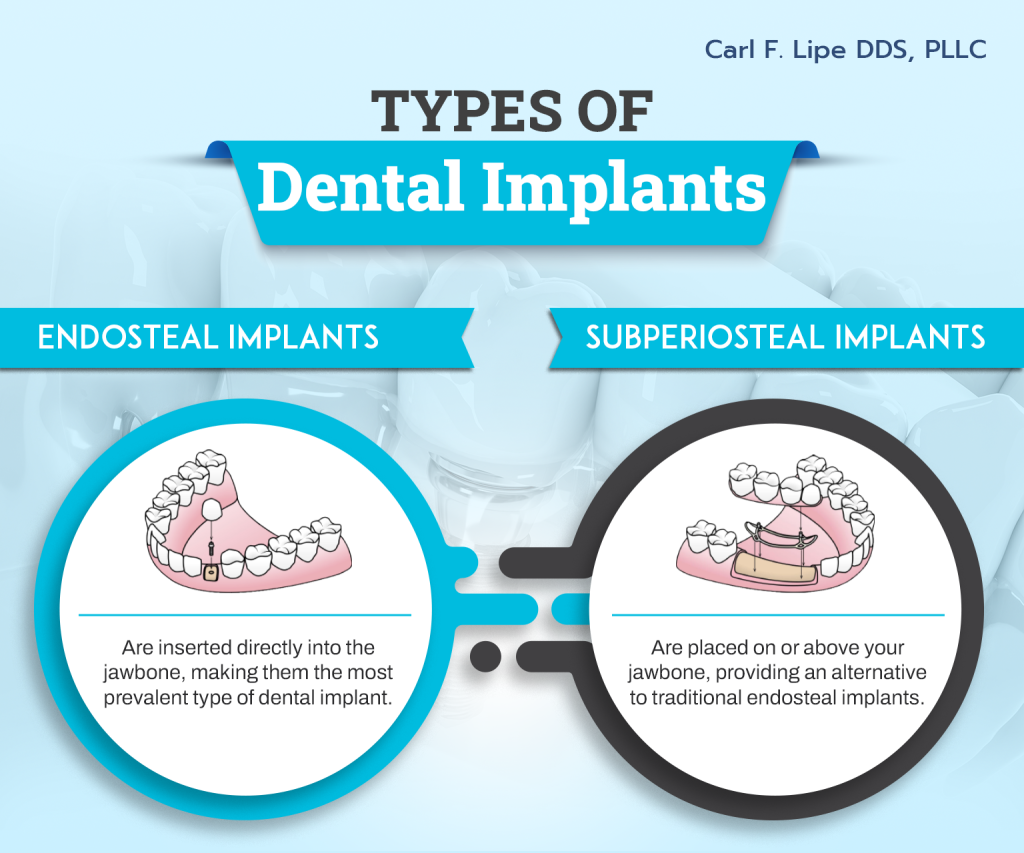The invention of dental implants has changed the field of dentistry by giving an enduring and profoundly proficient method for supplanting lost teeth. This remarkable innovation has helped dentists restore the natural smile of their dental patients and also it has contributed to improving the overall quality of life.
However, there are different kinds of dental implants, and both patients and professionals need to know the differences between them. In this article, we will investigate two main types of dental inserts: Subperiosteal and Endosteal. You will have a clear and brief understanding of their distinctive features, advantages, and indications by the end.
Endosteal Dental Implants
The most common type of dental implant is the Endosteal implant. To substitute for the root of a natural tooth, these implants are surgically inserted directly into the jawbone. Factors you need to know about endosteal implants are the following:
Endosteal implants come in a variety of sizes and shapes, including screws and cylinders, and are made of biocompatible materials like titanium. Their main feature is that they can be inserted directly into the jawbone, making it possible to support artificial teeth in a way that is both strong and stable.
Processes and placement
Placing endosteal implants requires a surgical process where the dentist will drill a hole directly into the jawbone and insert the implant. Before this process, an initial consultation will be organized that will ensure this kind of procedure is needed for your oral health. Gradually, the surrounding gum tissue will cover the implant, and over time, the bone fuses with the implant, providing a stable foundation for the artificial tooth.
Pros and Cons
The success rate and stability of endostal implants are excellent. Patients having sufficient jawbone density are the most suitable for this process. However, due to the surgical process, the healing process of this implant is longer.
Ideal Candidates
Individuals with good oral health, adequate jawbone density, and overall health are considered to be the best candidates for endosteal implants. Also, patients who are looking for a stable and permanent tooth replacement option are the ideal one for an endosteal implant.
Subperiosteal Dental Implants
Subperiosteal implants are considered to be the most effective alternative for those with insufficient jawbone density. Let’s dive deeper into this less common type of dental implant:
Subperiosteal implants are placed beneath the gum area but on the top of your jawbone. They include a metal body with posts that protrude through the gum to provide support to your artificial teeth. Patients lacking the necessary bone structure are ideal for this type of implant.
Procedure and Placement Process
Any type of drilling is not performed during the subperiosteal implant. Instead, the dentists place a metal framework on the top of the bone, with the posts extending through the gum. With time, the gum heals and gets adhered to the frame, stabilizing the implant.
Pros and Cons
Subperiosteal implants are a suitable option for individuals with bone loss or those who are not candidates for bone grafts. They involve a less-invasive procedure and typically have a shorter healing time.
Ideal Candidates
Subperiosteal implants are recommended for patients with reduced jawbone density, those who wish to avoid bone grafts, and those who need a quicker solution to tooth loss.
Key Difference Between Endosteal And Subperiosteal Implants

Till now we have covered the basics of these two implants. Now, we should focus on the differences between these two implants to help us understand which one will fulfill our dental needs.
| Aspect | Endosteal Implants | Subperiosteal Implants |
|---|---|---|
| Materials Used | Constructed with titanium and inserted directly into the jawbone. | Made of a metal framework that rests on top of the jawbone. |
| Surgical Technique | Requires a surgical process to drill into the jawbone. | Requires a less invasive procedure, performed on top of the bone. |
| Indications for Use | Suitable for most patients with adequate jawbone density. | Designed for individuals with insufficient bone volume who want to avoid bone grafts. |
| Long-Term Success Rates | Tend to have higher long-term success rates due to direct bone integration. | May exhibit reduced long-term stability but remain valuable for individuals with insufficient bone support. |
Final Thoughts
The invention of dental implants has revolutionized the dentist’s approach to treating tooth loss, providing robust and lifelike solutions. Understanding the differences between endosteal and subperiosteal implants is important for making informed decisions regarding your oral health.
Ultimately, the choice between these two types of dental implants should be based on your specific oral health needs and preferences. We strongly recommend consulting with a dental professional who can assess your condition and guide you toward the best treatment option. Your smile’s future could be brighter than ever with the right dental implant choice. Visit Dr. Carl F. Lipe and opt for effective oral health. Also follow us on facebook and instagram from latest dental health tips!
